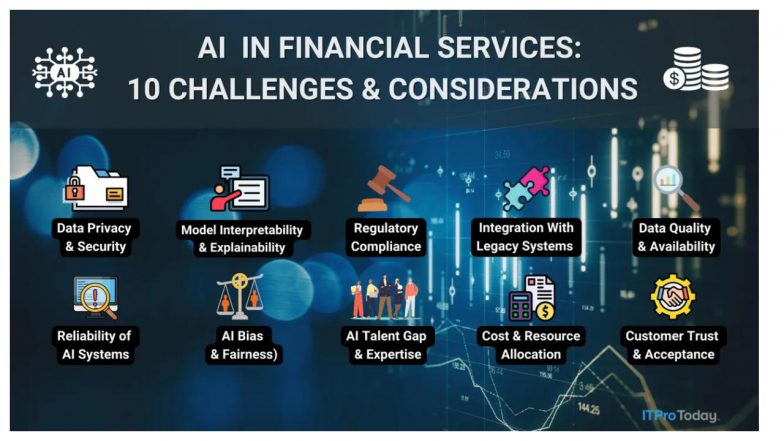Summary
The top ten most significant cybersecurity challenges for the financial services industry in 2025 are driven by increased digitalization and the evolving sophistication of threat actors.
OnAir Post: Financial Services Challenges
About
Financial Services Challenges
- Ransomware Attacks: These remain a primary and increasingly targeted threat. Attackers use “triple extortion” tactics, encrypting data, threatening public disclosure of sensitive information (customer PII, corporate records), and disrupting operations, which can result in significant financial losses and regulatory fines.
- Phishing and Social Engineering: These attacks exploit human error, often using AI to create highly convincing and personalized messages (emails, deepfake audio/video) to trick employees and customers into divulging credentials or sensitive data.
- Third-Party and Supply Chain Risk: The financial sector’s heavy reliance on third-party vendors and external services (cloud providers, payment processors, software suppliers) expands the potential attack surface. A breach in a single vendor can compromise multiple financial institutions, as seen in recent incidents with Santander and DBS Bank.
- AI-Powered Cyberattacks: Threat actors are increasingly leveraging AI and machine learning to automate attacks, create undetectable malware, and identify vulnerabilities faster than traditional methods, requiring financial institutions to deploy AI-driven defenses to keep pace.
- Cloud Security Vulnerabilities: As more financial institutions move to hybrid or fully cloud-based infrastructures, misconfigurations and unaddressed vulnerabilities in these environments present new entry points for attackers aiming to steal data or disrupt services.
- API Vulnerabilities: The growing use of Application Programming Interfaces (APIs) for open banking and system integration creates new entry points. Inadequately protected APIs can be exploited for data theft, credential compromise, and supply chain attacks.
- Insider Threats: Both malicious and accidental actions by authorized users pose significant risks. Disgruntled employees might steal data, while others might inadvertently fall victim to social engineering, leading to major breaches or operational disruptions.
- Evolving Regulatory Compliance: The financial industry operates in a heavily regulated environment (e.g., GDPR, CCPA, EU’s DORA). Keeping up with the complex and evolving compliance demands and avoiding severe penalties for non-compliance is a continuous challenge.
- Advanced Persistent Threats (APTs) and State-Sponsored Attacks: Due to their critical role in the economy, financial organizations are prime targets for highly targeted, prolonged attacks by sophisticated groups and nation-states aiming for data theft, espionage, or systemic disruption.
- Mobile Device and New Technology Exploits: The proliferation of mobile banking, IoT devices, and even blockchain technologies (DeFi, smart contracts) introduces new vulnerabilities and expands the attack surface, which cybercriminals are actively targeting.
Source: Gemini AI Overview – 11/3/2025
Web Links
Innovations
Source: Other
- AI and Machine Learning (AI/ML) for Threat Detection and Fraud Prevention: AI/ML algorithms analyze massive datasets in real-time to identify unusual patterns, flag suspicious transactions, and predict potential threats with an accuracy and speed that surpasses traditional methods.
- Zero Trust Architecture (ZTA): This security model operates on the principle of “never trust, always verify,” enforcing strict access controls and requiring verification at every interaction point, regardless of whether the user or device is inside or outside the network perimeter.
- Multi-Factor Authentication (MFA) and Behavioral Biometrics: MFA adds essential layers of identity verification beyond simple passwords (e.g., app-based authenticators, SMS codes, or security keys). Behavioral biometrics further enhances this by analyzing unique user behaviors (e.g., typing patterns, voice recognition, or navigation) to detect anomalies in real-time.
- Advanced Data Encryption and Tokenization: Robust encryption protocols secure sensitive data both at rest and in transit, rendering it unreadable if intercepted by unauthorized parties. Tokenization further protects payment card information by replacing it with a unique, non-sensitive symbol.
- Cloud Security Solutions: As financial institutions migrate operations to the cloud for scalability and cost-efficiency, advanced cloud security measures — including automated configuration scans, stringent access controls, and data loss prevention (DLP) tools — are crucial to manage new vulnerabilities.
- Blockchain Technology: Beyond cryptocurrencies, blockchain provides an immutable, transparent, and distributed ledger for transactions, enhancing security and traceability for areas like cross-border payments and record-keeping, which reduces the risk of fraud and data breaches.
- Security Orchestration, Automation, and Response (SOAR) and Extended Detection and Response (XDR): These solutions integrate various security tools into a cohesive framework, allowing for the automation of routine tasks, faster incident response times, and a unified approach to managing complex threats across the entire digital landscape.
- API Security: The rise of Open Banking and embedded finance means that secure Application Programming Interfaces (APIs) are critical. Innovations in API security focus on robust validation, granular authorization, and continuous monitoring to prevent exploits at these key integration points.
- Regulatory Technology (RegTech) and Continuous Compliance: RegTech leverages AI and automation to help financial institutions navigate the complex and evolving regulatory landscape (e.g., GDPR, DORA, PCI DSS). This ensures continuous monitoring, automated reporting, and proactive risk management, avoiding heavy fines and maintaining trust.
- Quantum-Resistant Encryption (Post-Quantum Cryptography): While current encryption methods are strong today, financial institutions are beginning to invest in and plan the transition to quantum-resistant algorithms to preemptively safeguard long-term data against the potential threat of future quantum computers capable of breaking current codes.


